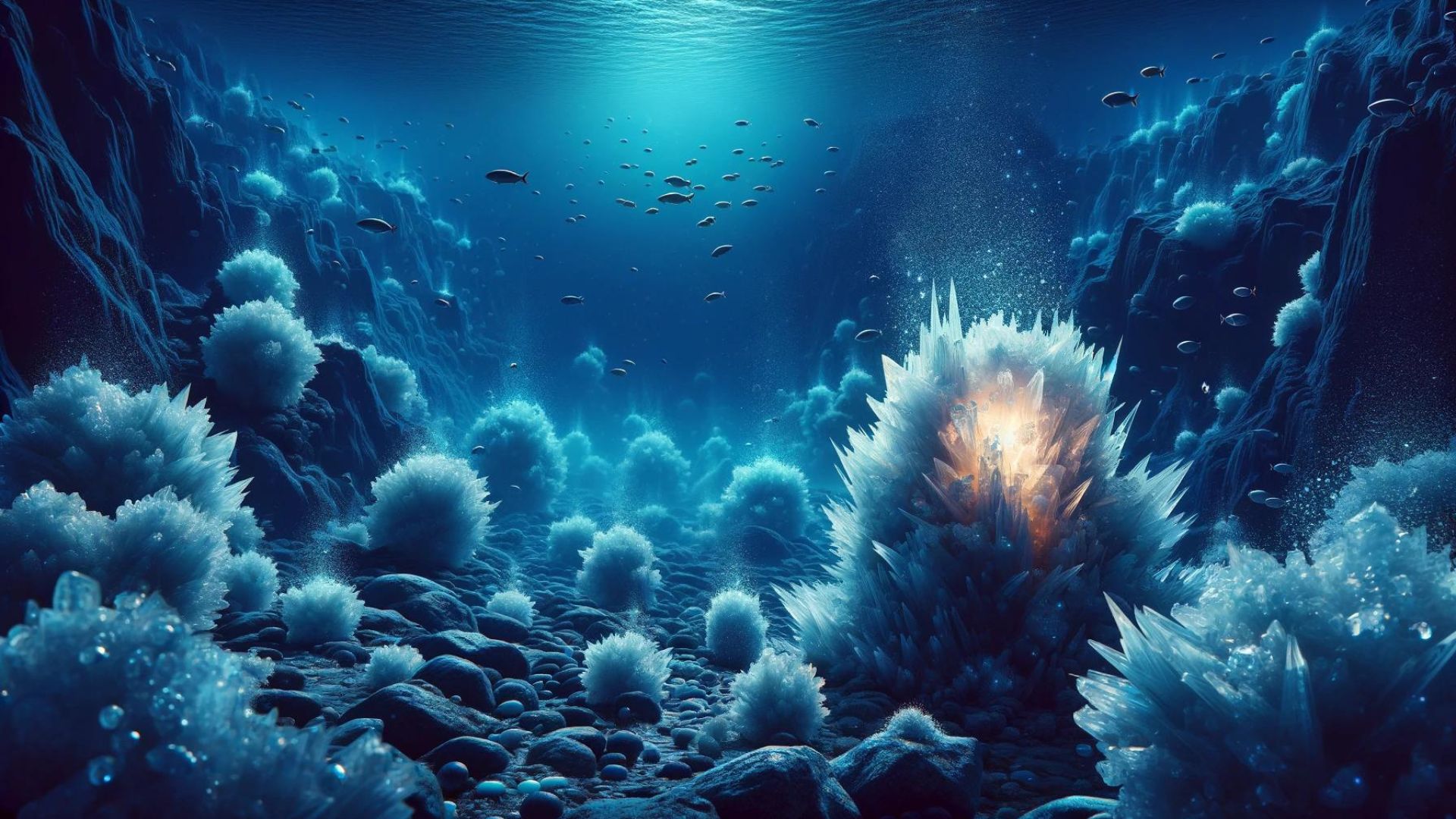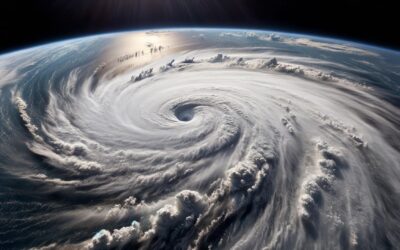Article Audio
[spreaker type=player resource=”episode_id=58999568″ width=”100%” height=”200px” theme=”dark” playlist=”false” playlist-continuous=”false” chapters-image=”true” episode-image-position=”left” hide-logo=”false” hide-likes=”false” hide-comments=”false” hide-sharing=”false” hide-download=”true”]Methane Hydrates (Fire Ice)
Have you ever heard of a substance that can burn with a bright flame while being encased in ice? This paradoxical phenomenon is not a trick of magic but a marvel of nature known as methane hydrates. Often referred to as “fire ice,” methane hydrates hold a story of wonder, warning, and wisdom that underscores the majestic complexity of our planet Earth.
Methane hydrates are crystalline structures that form under the high-pressure, low-temperature conditions found in ocean sediments along continental margins and beneath the permafrost in polar regions. These compounds consist of methane molecules trapped within cages of water molecules, creating a solid that eerily resembles ice but holds a flammable gas at its core.
The discovery of methane hydrates is a relatively recent chapter in the saga of scientific exploration, yet it represents a significant one, highlighting the untold mysteries of our planet’s depths. The volumes of methane locked within these hydrates are immense, with estimates suggesting they contain more carbon than all the world’s oil, natural gas, and coal reserves combined. This revelation points to the potential for both energy resources and environmental challenges, drawing a fine line between exploitation and preservation.
The Majestic and the Cautionary
The existence of methane hydrates is a testament to the incredible conditions and processes that govern our planet’s functioning. It showcases the beauty of Earth’s chemistry and the delicate balance maintained in ecosystems, even those as remote and unexplored as the deep sea. However, this beauty comes with a cautionary note about the fragility of our planet’s equilibrium.
Methane is a potent greenhouse gas, and the destabilization of methane hydrates can lead to significant releases into the atmosphere, exacerbating global warming and climate change. This potential impact highlights the need for careful scientific study and environmental stewardship to ensure that the exploration of such resources does not come at an unacceptable cost to our planet’s health.
Connecting to Our Lives
You might wonder how methane hydrates, hidden in the ocean’s depths, relate to our everyday lives. The answer lies in the interconnectedness of Earth’s systems. The stability of methane hydrates is directly influenced by ocean temperatures and sea-level changes, making them sensitive indicators of climate change. As stewards of our planet, understanding the existence and role of methane hydrates compels us to consider our actions’ impact on the environment.
Real-Life Examples of Impact and Action
Consider the research expeditions dedicated to studying methane hydrates, which not only aim to understand their potential as an energy source but also assess the risks associated with their disturbance. These scientific endeavors underscore the importance of informed decision-making in harnessing natural resources, balancing technological advancement with environmental preservation.
Furthermore, initiatives focused on reducing greenhouse gas emissions and transitioning to renewable energy sources directly contribute to maintaining the stability of methane hydrates by mitigating global warming. Each step taken towards sustainability and environmental consciousness helps protect these and other marvels of our planet.
A Call to Action
The story of methane hydrates is a call to appreciate and preserve the beauty and complexity of our Earth. It reminds us that our actions have far-reaching consequences, not just for our immediate surroundings but for the hidden corners of our world. As we marvel at the wonders of methane hydrates, let us also commit to being active participants in protecting our planet.
Here’s how you can make a difference:
- Support and advocate for research and policies that prioritize sustainable energy resources.
- Reduce your carbon footprint through conscious lifestyle choices, such as using energy-efficient appliances, reducing waste, and supporting renewable energy.
- Educate others about the significance of methane hydrates and the importance of ocean conservation.
As you go about your daily life, remember that the health and beauty of our planet depend on the choices we make. Let the intrigue of methane hydrates inspire you to learn more, share your knowledge, and take action towards a more sustainable and conscious relationship with our Earth. Together, we can ensure that the fire ice of our oceans continues to tell a story of wonder, not warning, for generations to come.
Why Should You Care?
Understanding methane hydrates is crucial because they represent a significant part of our planet’s carbon cycle and have the potential to both contribute to and mitigate climate change. Their study offers insights into sustainable energy resources, the intricacies of climate science, and the importance of preserving our planet’s delicate ecological balance.
Key Takeaways:
- Majestic Complexity of Earth: Methane hydrates showcase the intricate and fascinating chemical and physical processes that operate within Earth’s ecosystems.
- Environmental Impact: The potential release of methane from hydrates poses a significant risk to climate stability, emphasizing the need for careful environmental management.
- Energy Potential and Risks: Methane hydrates contain immense amounts of carbon, offering energy possibilities and environmental challenges.
- Interconnectedness: The study of methane hydrates underscores the interconnectedness of Earth’s systems and the importance of our actions on environmental health.
- Conservation and Action: The existence of methane hydrates is a call to action for environmental stewardship and sustainable living practices.
Keywords and Definitions:
- Methane Hydrates: Crystalline structures formed under specific conditions in ocean depths, containing methane trapped within water molecules.
- Greenhouse Gas: Gases, like methane, that trap heat in the Earth’s atmosphere, contributing to global warming and climate change.
- Fire Ice: A colloquial name for methane hydrates, reflecting their ability to burn while appearing as ice.
- Ocean Sediments: Deposits of organic and inorganic particles on the ocean floor, where methane hydrates are commonly found.
- Continental Margins: The edges of continental plates submerged in the ocean, often hosting methane hydrate deposits.
- Permafrost: Permanently frozen ground found in polar regions, also containing methane hydrates.
- Climate Change: Long-term alterations in temperature, precipitation, and other atmospheric conditions, often driven by human activities.
- Sustainable Energy: Energy obtained from renewable sources that do not deplete the resource or harm the environment.
- Carbon Footprint: The total amount of greenhouse gases produced to directly and indirectly support human activities.
- Ecological Balance: The equilibrium between, and harmonious coexistence of, the components of an ecosystem.
Frequently Asked Questions:
Can methane hydrates be used as a reliable energy source?
While methane hydrates hold significant potential as an energy resource due to the vast amounts of methane they contain, extracting them poses technological and environmental challenges. The risk of triggering uncontrolled methane releases and exacerbating climate change requires cautious and responsible exploration.
How are methane hydrates related to climate change?
Methane hydrates can both influence and be influenced by climate change. The release of methane from hydrates into the atmosphere can accelerate global warming. Conversely, rising temperatures can destabilize methane hydrates, creating a feedback loop that further impacts climate change.
Myth Buster:
Myth: Methane hydrates are an immediate solution to the world’s energy crisis.
Reality: Despite the vast amounts of methane they contain, the extraction of methane hydrates is complex and fraught with environmental risks. While they represent a potential energy source, their role in contributing to climate change makes them a double-edged sword that requires careful consideration and further research.
Let’s Talk:
- How do you think the potential energy benefits of methane hydrates weigh against the environmental risks?
- What actions can individuals and communities take to contribute to the preservation of ecological balance and mitigate the impact of climate change?
- In what ways can we support sustainable energy research and development to minimize reliance on fossil fuels?
Share your thoughts and opinions in the comment section. Let’s engage in a meaningful conversation about the preservation of our planet and the role we can play in fostering a sustainable future.












0 Comments